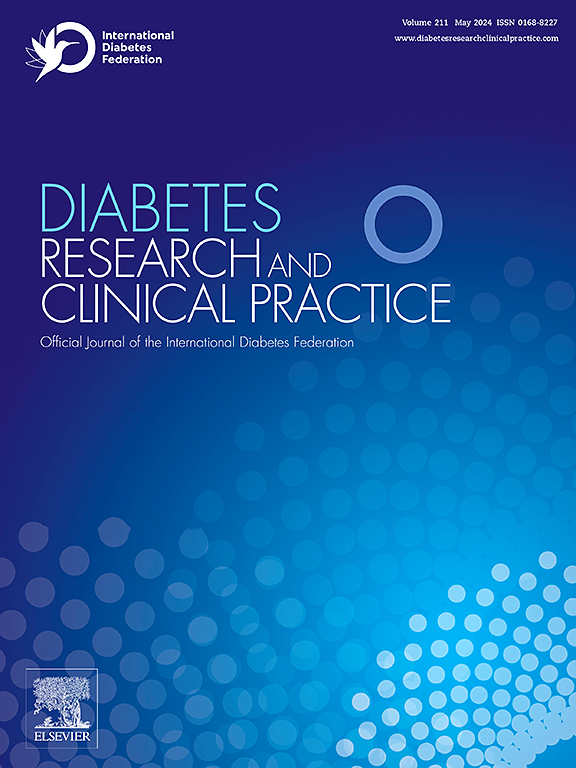老年脆性 2 型糖尿病患者的胰岛素自动输送系统。
IF 6.1
3区 医学
Q1 ENDOCRINOLOGY & METABOLISM
引用次数: 0
摘要
目的:老年糖尿病因其体弱多病而变得复杂,这些患者在使用胰岛素时出现低血糖的情况并不少见。胰岛素自动给药系统(AID)可更好地控制老年脆性 2 型糖尿病患者的血糖:包括癌症患者在内的 34 名脆性糖尿病患者(≥ 60 岁)从多剂量胰岛素(MDI)治疗转为使用 AID 系统。对患者的 HbA1c 水平、体重、每日胰岛素总需要量、C 肽、肌酐和血脂进行了至少六个月的随访:34 名患者(14 名男性,41.2%)的中位年龄为 67 岁(IQR 为 63.0-75.5)。6名患者(17.6%)正在接受化疗和/或类固醇治疗(Ch/S)。患者最初的 HbA1c 中位数为 9.3(IQR 7.6-11.0),c 肽水平为 0.9(IQR 0.5-2.2)纳克/毫升,每日胰岛素总剂量中位数为 41 IU(IQR 32-53)。转用 AID 系统六个月后,患者的 HbA1c% 降至 7.1(IQR 6.5-8.1),p 180 mg/dL 为 26.7%,> 250 mg/dL 为 6.7%:虽然 AID 系统主要在年轻的 1 型糖尿病患者中进行测试,但我们的结果表明,患有脆性 2 型糖尿病的老年患者也能从 AID 系统中获益。即使是非常虚弱的病人,如癌症病人,也能从中获益。本文章由计算机程序翻译,如有差异,请以英文原文为准。
Automated insulin delivery systems in elderly patients with brittle type 2 diabetes
Purpose
Geriatric diabetes is complicated by the frailty of this population, and hypoglycemia with insulin is not uncommon in these patients. Automated Insulin Delivery (AID) systems may provide better glycemic control in elderly patients with brittle type 2 diabetes.
Methods
Thirty-four patients (≥ 60 years) including cancer patients with brittle diabetes were switched to an AID system from multiple-dose insulin (MDI) treatment. HbA1c level, weight, total daily insulin requirement, and C-peptide, creatinine, and lipids were followed for at least six months.
Results
There were 34 patients (14 male, 41.2 %) with a median age of 67 (IQR 63.0–75.5). Six patients (17.6 %) were on chemotherapy and/or steroids (Ch/S). The patients’ initial median HbA1c % was 9.3 (IQR 7.6–11.0), c-peptide level was 0.9 (IQR 0.5–2.2) ng/mL, and median total daily insulin dose was 41 IU (IQR 32–53).
Six months after the patients were switched to an AID system their HbA1c % decreased to 7.1 (IQR 6.5–8.1), p < 0.001 and c-peptide increased to 1.21 (IQR 0.2–1.7) ng/mL, p = 0.878. Total insulin dose decreased with AID systems [32 IU (IQR 23.9–37.8)), p < 0.001].
There was a decrease in median HbA1c % in patients on Ch/S [8.7 (IQR 7.0–11.5) to 6.9 (IQR 6.3–9.2)] however it didn’t reach statistical significance p = 0.225. Total insulin dose also decreased without statistical significance [33 IU (IQR 41–28) to 28 (IQR 23–35), p = 0.173].
The mean time in range (TIR) percent of the patients with AID systems were as follows; <54 mg/dL was 0.5 %, 56–70 mg/dL was 1.3 %, 70–180 mg/dL was 64.8 %, >180 mg/dL was 26.7 % and > 250 mg/dL was 6.7 %.
Conclusion
Although AID systems are tested mostly in young type 1 patients our results show that elderly patients with brittle type 2 diabetes also benefit from an AID system. Even in very frail patients such as cancer patients, improvement can be seen.
求助全文
通过发布文献求助,成功后即可免费获取论文全文。
去求助
来源期刊

Diabetes research and clinical practice
医学-内分泌学与代谢
CiteScore
10.30
自引率
3.90%
发文量
862
审稿时长
32 days
期刊介绍:
Diabetes Research and Clinical Practice is an international journal for health-care providers and clinically oriented researchers that publishes high-quality original research articles and expert reviews in diabetes and related areas. The role of the journal is to provide a venue for dissemination of knowledge and discussion of topics related to diabetes clinical research and patient care. Topics of focus include translational science, genetics, immunology, nutrition, psychosocial research, epidemiology, prevention, socio-economic research, complications, new treatments, technologies and therapy.
 求助内容:
求助内容: 应助结果提醒方式:
应助结果提醒方式:


